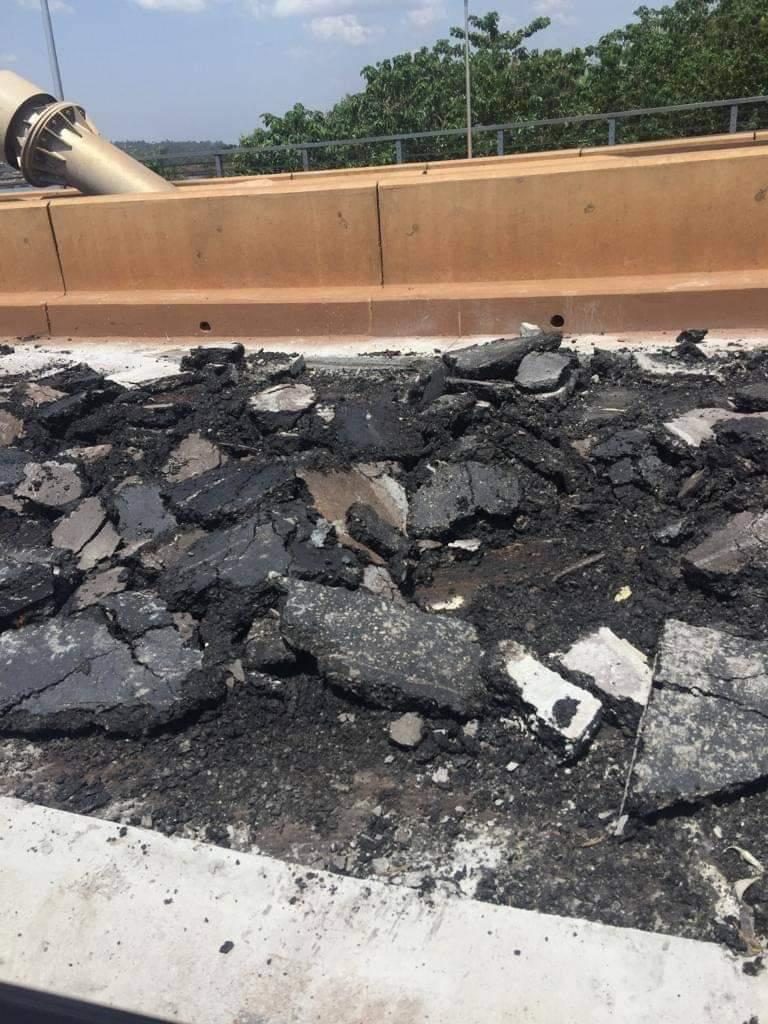Ugandans on Sunday were dismayed to find an on going activity on the newly commissioned, glamorous single cable bridge spanning River Nile that connects to Jinja Town in Eastern Uganda.
During the launch, government through Uganda National Roads Authority (UNRA) announced it would be named Source of the Nile Bridge.
For some time, Ugandans irrespective of their political affiliations applauded the authorities for erecting such a magnificent structure which cost shs 450 billion with a life span of 120 years.
Among others, the bridge had extraordinary features which include;
The 525m-long bridge has a central span of 290m, end spans of 135m and 100m on the East and West banks respectively.
The overall width of the Bridge is 22.9m. It has a dual carriageway 7.0m wide with a pedestrian walk way of 2.25m wide on both ends. For security at night, the Bridge will have lighting facilities.
The bridge’s foundation of 1.5m and 2.0m diameter piles are embedded approximately 14-23m deep into hard rock.
The new 1.83km long asphalt approach roads has three grade junctions at Nile Breweries, Nytil and Jinja round- about to allow interchange of traffic to the existing road network.
Cracks
Three months into operation, the bridge developed cracks on its outer layer partly on the lane used by motorists heading to Kampala from the East.
Most of the vehicles are heavily loaded with fuel and several other products from the coast since Uganda is landlocked.
Pictures began emerging on social media as the contractor removed the layer which was termed as asphalt.
UNRA, experts explained that activity on the bridge will last for one month as they fix the cracked part of the bridge.
The pictures stirred anger among the citizens who questioned the credibility of the contractor and the continuous wastage of tax payer’s cash.
However, UNRA through its communications manager Allan Ssempebwa organized a statement to explain the resumption of works on Nile Bridge.

“In an earlier communication, the Uganda National Roads Authority [UNRA] informed the public that the Contractor on the Source of the Nile Bridge in Jinja was conducting several tests to form a base line data for the Bridge Structural Health monitoring,” said Mr. Ssempebwa.
Adding that, “We also added that the wearing course seen and referred to as ‘bumpy’ or cracked by a section of the public is a non structural attachment and therefore not a defect on the bridge.”
UNRA explained that thereafter the will be replaced with permanent asphalt as soon as investigation on structural behaviour is concluded and baseline data is formed.
“This will be done within the defect liability period before contractor leaves the site.”
The reassurance was that the Contractor has completed all the tests and has embarked on plans to start application of permanent asphalt on the bridge deck but as a contractual requirement they are preparing a trial section of asphalt on the bridge at the length of approximately 100m on both approaches of the bridge.
But later, UNRA announced that after one month, still more tests will be conducted on the bridge before fixing permanent layer of asphalt.
Asphalt is an economical driveway surface option that’s cost-effective and low-maintenance.
What went wrong?
This website has since Sunday embarked on depth investigation to establish what could have caused the cracks on the newly built bridge and whether these cracks are structural.
We interviewed several experts, civil engineers (structural) both in private practice and government and other authorities in related fields.
In our investigation, we found out that the cracks developed on a left lane (Jinja to Kampala) also termed as import lane.
This is the lane used by heavy trucks carrying cargo from the coast in Kenya.
An expert in private practice who asked to remain unnamed said, in such a scenario two things must have happened;
Shoddy work on the bridge that the asphalt on the outer layer can’t match the exiting weight of the load.
“This causes constant expansion and contraction of the mixture and hence cracks,” said John (not real names).
Another engineer suspects that, the trucks from Kenyan are beating the weighbridge and so are loading more than required.
“You might find that truck owners/drivers are conniving with URA officials and are loading more than what is required. This automatically will affect the bridge given that it’s a suspension structure not basing on ground. You must know that its support is the cables,” said the engineer.
The third expert who works with Ministry of Works and wished to remain unnamed in order to protect his job wondered how the contractor could mess with the mixture.
“Asphalt and concrete are different mixtures,” he began his narration.
Adding, “The bridge is made of concrete. Therefore, to get asphalt and fix it on concrete was a complete waste of time.”
“The two mixtures don’t bond. They are different material. It is like adding water in oil. They can’t be the same,” he said.
He reasons that asphalt and concrete contracts and expands at different intervals.
“Even a blind person can tell that automatically the bridge had to crack.”
Asked the depth of the crack whether they affected the structure, this engineer said he needed to get more information.
He said the solution is to remove asphalt and most likely replace it with pavers.
Mr. Allan Ssempebwa, UNRA’s communications specialist laughed off the engineers’ assessments saying there is no cause of alarm.
He wondered whether the same trucks which enter Kampala use a different route back to Kenya.
But the logic is that while returning to Kenya most of the heavy trucks are either empty or carrying less cargo with less wait.
That explains why the right lane is still intact.